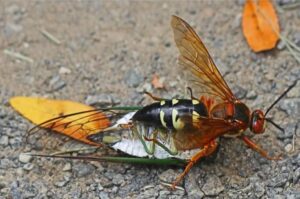In recent years, a menacing insect has been wreaking havoc in the United States, leaving a trail of fear and devastation in its wake. The giant killer wasp, aptly nicknamed the “deadly hornet,” has been terrorizing the country since its emergence in 2019.
This invasive and highly destructive insect is considered the largest and most dangerous of its kind in the world. Its aggressive behavior and potent sting make it a formidable foe, capable of decimating entire bee colonies and posing a significant threat to human safety.
The giant killer wasp’s megamandibles are its most distinctive feature, allowing it to kill and decapitate thousands of bees with ease. Its ability to take over hives and defend them aggressively has earned it a reputation as a ruthless predator.
The emergence of the giant killer wasp serves as a stark reminder of the threats that nature can pose. Efforts to monitor, control, and mitigate this invasive species are crucial to safeguarding ecosystems and public safety.
Native to East Asia, the Asian giant hornet, or Vespa mandarinia, is a large wasp known for its aggressive behavior and potent sting. These hornets can grow up to 2 inches in length, making them one of the largest hornet species in the world.
Their distinct yellow and black coloration, large rounded head, and prominent mandibles make them a formidable sight. But it’s their behavior that’s truly alarming – they’re known to be aggressive, especially when their nests are threatened, and can sting multiple times, causing severe pain and allergic reactions in humans.
While the giant killer wasp is undoubtedly a dangerous insect, it’s worth noting that fatalities from its sting are rare, usually occurring in individuals with severe allergic reactions.

In fact, the world’s most dangerous insect is often considered to be the mosquito. These tiny insects are responsible for transmitting a variety of deadly diseases, including malaria, dengue fever, Zika virus, and West Nile virus.
Mosquitoes transmit diseases to humans through their bites, injecting saliva containing anticoagulants and pathogens into the bloodstream. The ability of mosquitoes to carry and transmit these pathogens makes them significant vectors for various infectious diseases.
While the giant killer wasp is undoubtedly a formidable foe, it’s essential to recognize the dangers posed by other insects, like mosquitoes, and take steps to mitigate these threats. By understanding the risks and taking proactive measures, we can work towards creating a safer and healthier world for all.



